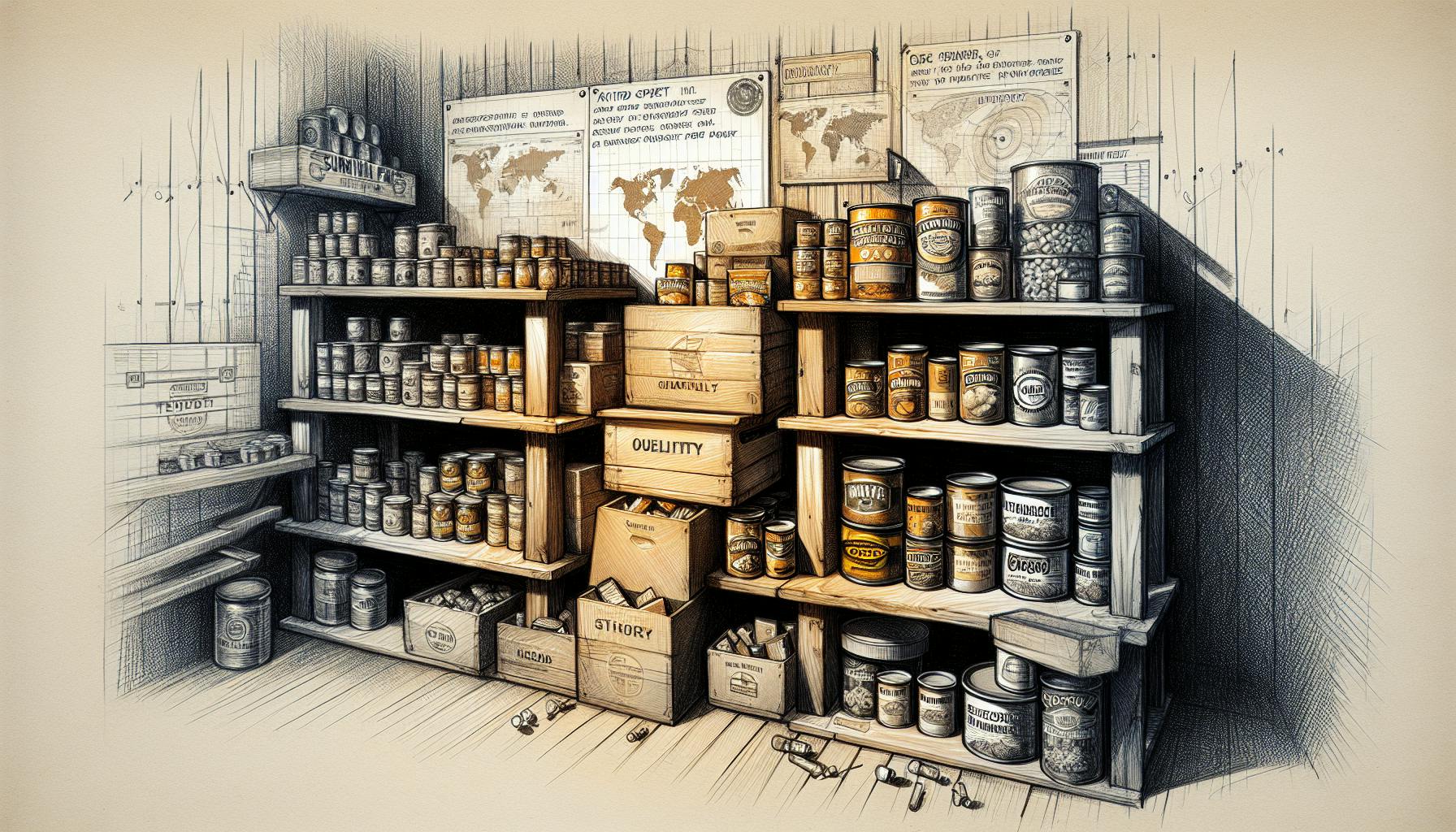Preparing for emergency situations is crucial, and most would agree that having the right supplies in a bug out bag can make all the difference in an evacuation.
Packing nutritious, lightweight, non-perishable foods specifically selected for survival needs allows you to travel farther and faster to safety.
In this article, we'll discuss the best food options for bug out bags, focusing on lightweight yet calorie-and-nutrient-dense foods that don't require refrigeration and won't weigh you down.
Essentials of Lightweight Bug Out Bag Nourishment
This section emphasizes the importance of packing lightweight, non-perishable foods in your bug out bag to ensure you have sustenance without overburdening yourself.
Understanding the Bug Out Bag Philosophy
A bug out bag is designed to be a compact, efficient emergency kit in case you need to evacuate quickly. The goal is to pack only the essentials to survive for 72 hours, so every item needs to be as lightweight and space-saving as possible. This means choosing foods that provide energy and nutrients without requiring refrigeration or taking up much room.
The Role of Food in Survival Situations
In an emergency, food provides more than just calories - it also supplies comfort and normalcy. However, since a bug out situation means moving fast with limited cargo space, you need to prioritize compact, long-lasting options. Foods that require minimal preparation are also key. The ideal bug out bag contains foods that deliver high nutritional value, an energy boost, essential hydration, and a taste of home when you need it most.
Examples include beef jerky, granola bars, canned tuna, dried fruits, trail mix, peanut butter packets, and electrolyte powders. Multivitamins help fill any nutritional gaps. Avoid heavy foods like cans, perishables that require refrigeration, or anything that takes up excess space without providing enough nutritional or comfort value.
With the right lightweight, non-perishable foods, your bug out bag will contain the critical nourishment you need to survive an emergency situation.
What food should I put in a bug out bag?
When packing food for your bug out bag, it's important to focus on lightweight, non-perishable items that are easy to prepare and transport. Some good options to consider include:
Freeze-dried meals
Freeze-dried meals like those from Backpacker's Pantry are lightweight, compact, and have a long shelf life. They just require boiling water to prepare, which makes them ideal for on-the-go situations. Some popular picks are pasta primavera, chicken and rice, or beef stroganoff.
Protein bars
High protein bars can provide a quick energy boost and help you meet daily nutrition needs. Look for options that contain at least 10-15 grams of protein with limited sugar. Kind Protein bars, Clif Builder's bars, and Quest bars are all solid choices.
Beef jerky
Beef jerky is tasty and filling, while also being shelf-stable and lightweight. It's a handy protein source to have on hand. Just be mindful of sodium levels and choose a low-sodium variety if possible.
Canned fish
Tuna, salmon, or chicken packed in water provides essential proteins and nutrients. The pop-top cans are quick and easy to open. Just make sure to pack a can opener as a backup.
When preparing your bug out bag, check expiration dates on any food items regularly and replace them as needed. Having emergency food supplies that last a long time without refrigeration is key.
What food should I pack in my emergency bag?
When packing food for your bug out bag, it's important to focus on lightweight, non-perishable items that are easy to transport and will sustain you in an emergency situation. Here are some of the best food options to include:
- Canned goods: Canned meats, fruits, vegetables, soups, etc. are shelf-stable and packed with nutrients. Choose low-sodium options whenever possible.
- High protein snacks: Beef jerky, tuna packets, peanut butter packets, and protein bars are excellent sources of protein and won't spoil without refrigeration.
- Dried fruits and nuts: Raisins, cranberries, almonds and more are tasty, nutritious, and lightweight.
- Crackers: Pack saltines, graham crackers, or other sturdy crackers that won't easily break. Pair with peanut butter for added protein.
- Granola/cereal/trail mix: Look for whole grain, low-sugar varieties to provide slow-burning energy.
- Comfort foods: Small treats like chocolate or candy bars can lift morale in stressful situations. Prioritize calorie-dense choices.
No matter what foods you choose, check expiration dates and plan to rotate items out of your bag every 6-12 months to ensure freshness. Also be sure to pack multivitamins to fill any nutritional gaps and electrolyte mixes to support hydration. With the right selection of compact, hearty foods, you'll be fueled up for any emergency scenario.
What is the best non perishable food for emergency?
When packing non-perishable food for your emergency kit or bug out bag, it's important to focus on lightweight, nutritious options that don't require refrigeration. Some great choices include:
Canned and Pouched Foods
- Canned foods like chili, soup, and spaghetti can provide calories and stay fresh for years if unopened. Look for low-sodium options.
- Pouched tuna, salmon, chicken, and other proteins offer protein. Tuna and chicken can also be found canned.
- Fruit cups and applesauce pouches are tasty portable options.
High-Calorie Snack Foods
- Granola, protein, or energy bars are lightweight and nutrient-dense.
- Nuts, seeds, and nut butters pack calories and healthy fats.
- Dried fruits like raisins, cranberries, and apricots store well.
- Beef jerky or other dried meats offer protein.
Other Essentials
- Choose non-perishable foods and check expiration dates.
- Bring a manual can opener if packing canned goods.
- Store items properly to extend shelf life.
- Pack water and electrolyte drinks like sports drinks or Pedialyte.
- Bring a multivitamin to fill any nutritional gaps.
When packing food for an emergency, focus on lightweight, non-perishable items that pack nutrition and calories. Prioritize canned goods, dried foods, nuts, jerky, and high-calorie snack items. Check expiration dates and pack a variety of foods.
What are the top 10 survival foods?
When building an emergency food supply, it's important to focus on non-perishable, nutrient-dense foods that don't require refrigeration. Here are 10 of the best survival foods to keep in your pantry:
Peanut Butter
An excellent source of protein, fats, and calories. Look for natural peanut butters without hydrogenated oils.
Whole-Wheat Crackers
Crackers made from whole grains provide good carbohydrates, fiber, and nutrients. Pair with peanut butter for protein.
Nuts and Trail Mixes
High in protein, healthy fats, and antioxidants. Stick to unsalted nuts in airtight containers.
Cereal
Choose whole grain cereals and granolas for fiber. Add shelf-stable milk or powdered milk.
Granola Bars
Granola bars provide a quick boost of carbohydrates and energy. Select bars with nuts and dried fruit for added nutrients.
Dried Fruits
Dried apricots, cranberries, raisins, etc. offer antioxidants. Prioritize unsweetened, low-sodium options.
Canned Tuna, Salmon, Chicken
Canned meats provide protein, healthy fats, calcium (with bones), and other nutrients. Aim for low-sodium versions packed in water.
Canned Vegetables
Canned green beans, carrots, peas, etc. provide key vitamins and minerals. Rinse before use to remove excess sodium.
The most practical survival foods don't require refrigeration and deliver balanced nutrition to keep you energized in an emergency situation. Prioritize less processed options in airtight containers and check expiration dates regularly.
sbb-itb-b932644
Selecting Non-Perishable Food for Your Go Bag
When preparing your bug out bag, it's important to select non-perishable foods that will last a long time without refrigeration. This ensures you have nutritious options available in an emergency situation.
Foods That Last: Identifying Non-Perishable Options
Focus on shelf-stable foods that are specially processed or packaged to resist spoilage. Some good options include:
- Canned goods like tuna, vegetables, and soups
- Dried fruits and vegetables
- Beef jerky or pemmican
- Granola, cereal, or protein bars
- Nuts and trail mixes
- Crackers
- Peanut butter or nut butters
- Canned nuts
- Vacuum-packed meals like pasta, rice, or stew
- Powdered milk, eggs, or meat substitutes
Choose foods with natural preservatives when possible for better nutrition. Properly stored white flour, rice, oats, sugar, and salt also last indefinitely.
The Importance of Checking Expiration Dates
When stocking non-perishable food in your bug out bag, be sure to:
- Check expiration or best-by dates on all items
- Set reminders to rotate and replace food every 6-12 months
- Inspect cans and packaging for damage before packing
- Store bags in cool, dark places to maximize shelf life
- Discard anything that smells bad or shows signs of spoilage
Staying on top of expiration dates ensures you have safe, nutritious options available in an emergency, instead of food that could make you sick.
Low-Sodium Options for Better Hydration
In survival situations, you need to be extra mindful of hydration. Choose low-sodium canned and dried goods when possible. Sodium dehydrates the body, while extra water intake helps counterbalance higher sodium foods.
Prioritize packing:
- Canned fruits packed in juice over heavy syrups
- Low-sodium soups and vegetables
- Unsalted nuts, seeds, and nut butters
- Dried fruits with no added sugars or preservatives
Be sure to pack enough water and stay vigilant about drinking enough each day. Having the right balance of fluids and electrolytes can mean the difference between life or death in an emergency.
Lightweight Food Choices for Backpack Survival
Choosing lightweight, nutritious foods is crucial for backpack survival preparedness. When packing your bug out bag, every ounce counts and you need food that will provide energy without weighing you down. Here are some of the best options to consider.
The Advantages of Freeze-Dried Food in Your Bug Out Bag
Freeze-dried foods are lightweight and compact, making them ideal for bug out bags. When water is removed, the food's weight and volume shrink dramatically compared to fresh foods. This allows packing more total calories in less space.
Freeze-dried foods are nutritious and filling. Popular options like freeze-dried fruits, vegetables, and entrees provide protein, carbs, fiber and various vitamins and minerals. They require no refrigeration and have long shelf lives of up to 25 years when stored properly.
Some good freeze-dried picks for bug out bags include:
- Backpacker's Pantry meals (various flavors)
- Mountain House entrees (beef stroganoff, chicken teriyaki, etc.)
- Wise freeze-dried fruits and vegetables
Properly Stored Flour: A Versatile Staple
Flour is calorie-dense and, when stored correctly, lasts a very long time without refrigeration. Hard wheat flour keeps several years if sealed from moisture and pests.
Flour allows flexibility in the field - mix with water to make bannock bread or use in other recipes. Combine with dried milk, sugar, baking powder and salt to make basic campfire pancakes or biscuits.
Ensure your bug out bag flour is:
- Kept in an airtight, waterproof container
- Stored in a cool, dark place
- Checked yearly for freshness and insect infestations
With proper storage, flour gives high calories and versatility.
Energy-Dense Foods: Nuts, Seeds, and Snicker Bars
Nuts, seeds and nut butters offer protein, healthy fats and carbs in small packages. They keep several months without refrigeration. Good picks include almonds, peanuts, cashews, sunflower and pumpkin seeds.
While heavy overall, small 2-3 oz trail mix bags provide quick energy boosts. Similarly, 1-2 Snickers bars give fast calories and elevation gain power.
A handful of nuts, seeds or an energy bar can help maintain strength and morale if longer-term food runs low. Just a small amount carries well and fuels high output.
Prioritize lightweight rations to avoid packing unnecessary ounces. Freeze-dried meals, flour, nuts and compact sweets are excellent options. Choose calorie- and nutrient-dense foods that don't require refrigeration and bring only what you reasonably expect to need.
Ready-to-Eat Go Bag Food Ideas
Beef jerky is a lightweight, protein-packed food perfect for bug out bags. As a preserved meat, it requires no refrigeration and has a long shelf-life, making it an ideal emergency food. Jerky comes in many flavors and provides a tasty source of protein to help you maintain strength during a crisis. Look for low-sodium options.
Tuna packets are another smart choice for bug out bag food. Canned tuna is heavy, whereas tuna pouches weigh very little. Tuna supplies protein, omega-3s, vitamin D, selenium, vitamin B12, and other nutrients. Tuna packets don't require a can opener and many don't even need water added. They make for an easy, nutritious meal on the go.
For an energy and nutrition boost, pack some energy shots, electrolyte mixes, and daily multivitamins. During stressful situations, energy levels and proper nutrition are important. A few small bottles or packets of these supplements don't take up much room and can go a long way if you need an extra push.
Other ready-to-eat foods like granola bars, trail mix, and dried fruits and veggies are lightweight and calorie-dense. Choose individually-wrapped items and check expiration dates regularly when stocking your bag. Rotate items to ensure freshness. With some planning, your bug out bag can contain plenty of tasty, healthy foods to get you through an emergency.
Hydration Solutions: Water and Electrolyte Drinks
Packing Water: The Essence of Survival
Water is the most essential item to include in your bug out bag. Without water, survival beyond a few days is extremely unlikely.
When packing water, lightweight, durable, BPA-free plastic bottles are ideal. Collapsible bottles take up minimal space. Bring at least 1 gallon per person for a 72-hour period. Consider packing water purification tablets as a backup.
Properly stored water lasts indefinitely. Check bottles occasionally for cracks and refill with fresh water every 6-12 months. Having an ample water supply gives you time to locate and purify additional water if needed.
Electrolyte Drinks to Prevent Dehydration
Electrolyte drinks help replenish minerals lost through sweat and prevent dehydration. They are especially useful during strenuous activities in hot weather.
Powdered electrolyte mixes are lightweight and shelf-stable. Simply add water when needed for an energy and hydration boost. Popular options include Pedialyte, Liquid I.V., and Nuun tablets.
Avoid sugary sports drinks as they can dehydrate you further. Instead choose lower-sugar or sugar-free electrolyte solutions. Just a few packets can make a critical difference in an emergency scenario.
Taste of Home: Backpackers Pantry and Valley Food Storage Options
Backpackers Pantry: Gourmet Meals on the Go
Backpackers Pantry offers a variety of lightweight, easy-to-prepare meals perfect for bug out bags. Their food comes in lightweight packaging that doesn't require refrigeration, making it an ideal choice for on-the-go situations. Some popular options include:
- Pad Thai: This classic Thai noodle dish includes rice noodles, vegetables, tangy tamarind sauce and peanuts. It's a tasty morale-booster when times get tough.
- Granola with Blueberries and Milk: This hearty breakfast option offers a nutritious start to the day with oats, nuts, dried blueberries and powdered milk.
- Chili Mac with Beef: A warm, comforting meal with pasta, beans, beef and a bold chili flavor.
These meals only require boiling water to prepare, so they're simple to make even in stressful circumstances. The familiar flavors provide a taste of home when you need it most.
Valley Food Storage Irish Pub Cheddar Potato: A Hearty Choice
Valley Food Storage's Irish Pub Cheddar Potato pouch offers a hearty, comforting bug out bag meal. This dish features potatoes, vegetables and rich cheddar cheese sauce. It's high in complex carbs to fuel your body with lasting energy.
The large single-serving pouch provides a substantial meal that can really fill you up. The rich, nostalgic flavor combats stress by offering a taste of simpler times. Just add hot water, let it sit for 15 minutes, and you'll have a satisfying meal ready to energize you for the challenges ahead.
With hearty yet portable dishes like these, it’s easy to keep yourself nourished no matter the situation. Just add hot water for a little taste of home when you need it most.
Conclusion: Assembling Your Ultimate Bug Out Bag Food Kit
When packing food for your bug out bag, the key is finding a balance between nutrition, weight, and shelf life. Choose calorie-dense foods that provide energy and won't expire quickly. Favor lightweight, non-perishable items that don't require refrigeration.
Here are some final tips for maintaining an effective food stash:
Final Checklist for Bug Out Bag Food Prep
- Focus on compact, lightweight foods like granola bars, beef jerky, and tuna packets
- Include a mix of proteins, carbs, fats to maintain energy levels
- Pack high-calorie foods like nut butters, dried fruits, and crackers
- Bring electrolyte drinks and a water filtration system
- Store food tightly in airtight, waterproof bags or containers
- Check expiration dates every 6 months, replacing old food items
Maintaining Your Food Kit: Rotation and Updates
As time passes, you'll need to rotate out food from your bug out bag to ensure freshness. Here's what to do:
- Set calendar reminders to check your food kit every 6 months
- Inspect all items, looking for expired or damaged products
- Consume and replace any opened packages or punctured pouches
- Update your food stash to account for dietary needs or taste preferences
- Consider an annual overhaul, donating old food to charity to start fresh
Keeping your food supply current takes discipline, but is vital for having an effective bug out bag when you need it most. Follow these tips to stay prepared.


